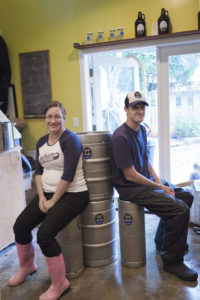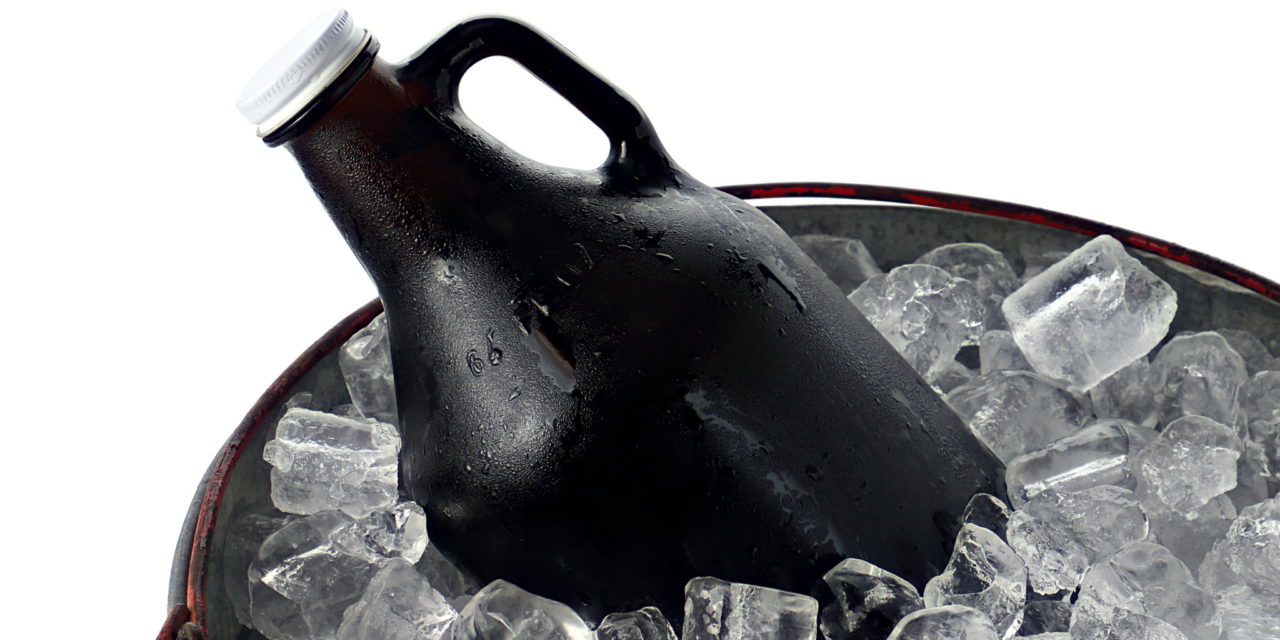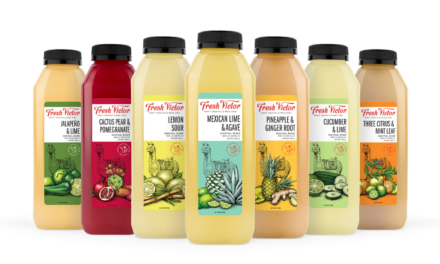Modern consumerism is driven, in large part, by convenience—on-the-go ordering, at-your-fingertips selection, on-demand delivery, ease-of-use packaging—and the alcohol beverage industry is reacting to the trend in various ways. One of the most popular is the refillable growler, which has been widely used in modern times by small craft brewers to deliver fresh beers to local customers. But growler programs (and their smaller counterparts, crowlers) can benefit producers and retailers in other beverage categories as well.

“Growlers give people more chances to share the beer with their friends who don’t come into the brewery, and that expands our audience.” —Matt Morriss, Rabbit Hole Brewing
“The main drive behind having a growler program is that it lets people bring home beers that are only available on draft,” says Matt Morriss, brewmaster at Rabbit Hole Brewing in Justin, Tex. (near Fort Worth). “This is a huge marketing opportunity, especially when you don’t have a huge marketing budget.
“Growlers give people more chances to share the beer with their friends who don’t come into the brewery, and that expands our audience,” he continues. “It brings in money at the same time, and you can’t do better than that with marketing.”
Growlers have also been key to Leikam Brewing (in Portland, Ore.) since before the nano-brewery even opened in 2015.
“When we decided to open a brewery, we wanted it to be community-focused,” says Sonia Marie Leikam, who runs the brewery with her husband, Theo. “We wanted to build relationships—to have human contact with our customers—and that’s why our growler program was such an important part of our business plan. When people come in to get beer, they talk to us and we find out what they like.”
This just goes to show how versatile and important growlers can be, no matter the size of the brewery. In recent years, growlers have proven so beneficial that they’re spreading from beer into wine, cider, spirits, and even coffee. But growlers also present a unique set of challenges, including (not surprisingly) legal ones, as well as problems involving quality control and the supply chain. But, say those who’ve taken the leap, those difficulties can be overcome—and it’s well worth doing so.
Growler basics

“The law is going to be different in almost every state, and those state regulations primarily govern how growlers are filled and sold, and the specific license type that’s required.” —Robert Lewis, LewisFox Law
One size does not fit all when it comes to growlers, which are available in specific shapes and sizes depending on the product to be contained and the legal requirements of the state where they’re used. The latter, say those who use growlers, can be daunting. Says attorney Robert Lewis, co-founder and partner at LewisFox Law in Coral Gables, Fla., “In a heavily regulated arena like alcohol, the law is going to be different in almost every state, and those state regulations primarily govern how growlers are filled and sold, and the specific license type that’s required.” He adds that state regulators have come a long way in their understanding of the concept, and that newfound understanding has let growler use grow and flourish.
Specifically, says Lewis, the legal issues can be divided into five categories:
The type of license. Does your liquor license allow or permit growler sales? The answer not only varies from state to state, but it must take into account any regulatory peculiarities within each state between on-premise and off-premise licenses.
Zoning and certificates of occupancy restrictions. City fire marshals closed several popular craft breweries in Dallas, Tex., over the 2017 holidays because their certificates of occupancy were issued for a warehouse and not for a building with an on-premise license. That meant the businesses were legally overcrowded when people came in to buy beer, because a warehouse isn’t supposed to have customers.
Growler size. The 64-ounce container is the most common, but growlers are available in a wide variety of shapes, materials, and volumes. Producers should choose what works best for them based on what’s allowed by law and depending on what’s going inside.
Sealed or open? Growlers have faced one of the most heated alcohol safety debates in the past 20 years. Many states moved aggressively to prohibit or regulate open containers to reduce drunk driving, meaning they required sealed growlers (sealed before distribution or appropriately sealed by the retailer)—another inconvenience for the producer.

Jayln Jager, account manager – beer and cider for Universal Packaging
Labeling. States have different restrictions about what information must appear on a growler label, including specific terms, federal alcohol warnings, and alcohol content.
This last issue is one reason many producers use stickers for labeling information on growlers. “We always tell our customers they need to educate themselves about what needs to go on the growler before they come to us,” says Jayln Jager, account manager – beer and cider for Universal Packaging, with locations near Vancouver, Wash., and Portland, Ore. “They should know their local liquor board better than we do.”
It’s about the marketing

“Just think of it as draft beer to-go.” —Julia Herz, Brewers Association
The legal requirements are step one. Step two is getting growlers to customers. Figures from the Brewers Association, which represents more than 70 percent of today’s 64,000 U.S. breweries, show that draft beer accounts for 41 percent of sales for its members. This compares to about 10 percent for big beer brands. And because growlers are draft beer, filled on the spot, “It’s a crucial component in the retail space,” says Julia Herz, BA’s craft beer program director. “Just think of it as draft beer to-go.”
Most small producers—whether wine, beer, spirits, or cider—sell a much smaller percentage of their products through the traditional three-tier system than do large producers. “A lot of seasonal or special release beers may only be packaged in keg, and some breweries don’t bottle or can any of their product, selling only to bars and restaurants,” says Morriss. “This is true for a lot of brewpubs that rely on onsite business for the bulk of sales, though production breweries—even small ones—still frequently sell the majority of their product through the three-tier system. In Texas, production breweries are forbidden by law from selling beer for off-premise consumption. This includes growlers. Brewpubs in Texas, however, can sell growlers and packaged beer to-go with some restrictions.
“Rabbit Hole converted from a production brewery license to a brewpub license in 2017 to take advantage of off-site package and growler sales. The bulk of our sales are still through the distributor system, but taproom sales have increased dramatically since making the switch.”
For many small producers, growlers help to make up that distributed difference, whether buying direct from the production facility, at a farmer’s market, or in similar off-premise venues. Says Leikam, “We still don’t have bottles on shelves in stores, so for us [refillable growlers are] about getting our beer out to people in another way.”

“Growlers are absolutely a wine thing.” — Christie Shertzer, Raptor Ridge Winery
In Oregon, Raptor Ridge Winery General Manager Christie Shertzer says the winery settled on 1-liter growlers instead of the more common 64-ounce beer size because, “We weren’t sure a 64-ounce growler would sell. It’s too much wine to consume too quickly, and it could compromise the wine’s quality.”
Raptor Ridge uses growlers in its tasting room and as part of its wine club, and the 10,000-case winery sells about 100 kegs per year (mostly for on-premise, by-the-glass pours). “About 25 percent are for our growler program,” she says, “but we’re planning on kegging more wine starting with the next bottling run, because the growler program is doing so well.”
Shertzer labels it an unqualified success, particularly with the choice of the 1-liter plastic growler: “It’s not super heavy, and it’s easy to transport. For the environmentally conscious, it’s the way to go. Growlers are absolutely a wine thing.”
Keep it clean
The other key to a successful growler program is quality control. Yes, it seems as if pouring beer into a specially made container would guarantee freshness, but it’s not that easy. For one thing, when the customer brings the growler back for a refill, it may not be as clean as it should be. Leftover dirt and grime can help the new product go off, and the customer could assume it’s a problem with the beer and not their cleaning skills. It’s also helpful to chill the growler before refilling and to fill from the bottom, as this will minimize foaming and reduce product waste. Many producers exchange returned, empty growlers with clean, prefilled ones, creating a self-sustaining cycle.

“As a brewer, getting to control what vessel your beer goes into is important.” —Sonia Marie Leikam, Leikam Brewing
Oxidation is a problem if air is in the container when the product is poured into it or if the fill and the seal aren’t perfect. If that happens, “the beer may begin to oxidize if not consumed within a couple of days,” says Morriss. “If purged well and sealed properly, a growler works exactly like a large bottle, and the beer should remain as fresh in the container as it would in a bottle. Once opened, though, the beer should be consumed within a day or else it will oxidize and go flat.”
This is where crowlers come in. They’re smaller, canned versions of a growler (usually around 32 ounces), and they’re filled by the producer from the same kind of keg used for growlers. The difference is that they avoid almost all of the growler problems—whether it’s an open container; whether the growler is clean enough, since the cans aren’t returned; and freshness.
“Growlers aren’t as sanitary as crowlers,” says Leikam, “and, as a brewer, getting to control what vessel your beer goes into is important. Also, people think that, because a growler has a lid that can be re-closed, their beer will magically stay good.”
Leikam Brewing used a Kickstarter campaign to purchase its crowler setup in 2017. “Crowlers are the answer for us, since we sell beer at so many locations,” says Leikam. “We don’t have to worry about anyone complaining about open containers at farmer’s markets, which can be a problem. And it helps with customers who don’t want a whole growler, only a pint or two.”
And making the customers happy is the goal for everyone.











